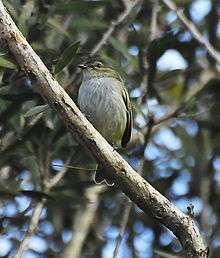Mistletoe tyrannulet
The mistletoe tyrannulet (Zimmerius parvus) is a very small bird, a passerine in family Tyrannidae, the tyrant flycatchers.
| Mistletoe tyrannulet | |
|---|---|
 | |
| Scientific classification | |
| Kingdom: | Animalia |
| Phylum: | Chordata |
| Class: | Aves |
| Order: | Passeriformes |
| Family: | Tyrannidae |
| Genus: | Zimmerius |
| Species: | Z. parvus |
| Binomial name | |
| Zimmerius parvus (Lawrence, 1862) | |
Taxonomy
The mistletoe tyrannulet was described in 1862 by the American amateur ornithologist George Newbold Lawrence under the binomial name Tyranniscus parvus.[2] It was formerly considered to be conspecific with the Guatemalan tyrannulet (Zimmerius vilissimus), but the species were split based on a molecular phylogenetic study published in 2013.[3][4]
Description
The mistletoe tyrannulet is a small bird, 11 - 12 cm in length as an adult. Adults have a slaty cap, a bright white supercilium ("eyebrow"), an olive-green back and conspicuous yellow edging along the wing.[5]
Distribution & Habitat
Appearance
The mistletoe tyrannulet ranges from Guatemala and Honduras south to the extremity of northwestern Colombia. It can be found in humid evergreen forest and edge, cultivation and semi-open areas with large trees. It is a fairly common to common bird across its range.
Vocalizations
This species is a very frequent caller, incessantly giving a call that has been rendered variously as peeyaik, pee-peeu or pee-yuip and sounds similar to that of the thick-billed euphonia (Euphonia laniirostris), another mistletoe-loving species.
Behaviour
Nesting
The mistletoe tyrannulet's nest is a globular mass of rootlets, mosses and other plant matter, hidden in a tangle or growth or in an epiphyte. The clutch is two whitish eggs, speckled rusty.[6]
Feeding
The mistletoe tyrannulet is an active forager, moving quickly about with its tail cocked as it searches for prey, mainly arthropods, amidst the foliage. It can be found as a member of a mixed-species feeding flock.[7] The bird also takes fruit, preferentially that of mistletoes (order Santalales).
References
- BirdLife International (2017). "Zimmerius parvus". IUCN Red List of Threatened Species. 2017. Retrieved 13 January 2018.
- Lawrence, George Newbold (1862). "Description of six new species of birds from the Isthmus of Panama". Ibis. 4: 10–12 [12]. doi:10.1111/j.1474-919X.1862.tb07468.x.
- Rheindt, F.E.; Cuervo, A.M.; Brumfield, R.T. (2013). "Rampant polyphyly indicates cryptic diversity in a clade of Neotropical flycatchers (Aves: Tyrannidae)". Biological Journal of the Linnean Society. 108 (4): 889–900. doi:10.1111/j.1095-8312.2012.02036.x.
- Gill, Frank; Donsker, David, eds. (2017). "Tyrant flycatchers". World Bird List Version 7.3. International Ornithologists' Union. Retrieved 9 January 2018.
- Ridgeley, Robert J.; Gwynne, John A. (1989). A Guide to the Birds of Panama.
- Howell, N.G.; Webb, Sophie (2017). A Guide to the Birds of Mexico & Northern Central America.
- Ridgeley, Robert J.; Gwynne, John A. (1989). A Guide to the Birds of Panama.
Howell, N.G.; Webb, Sophie (2017). A Guide to the Birds of Mexico & Northern Central America.
Ridgeley, Robert J.; Gwynne, John A., Jr. (1989). A Guide to the Birds of Panama.
